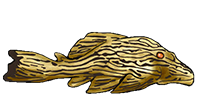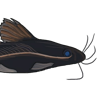 Summary of congoglanis Summary of congoglanis |
|---|
| Etymology | The region of the "Congo" and glanis meaning catfish. |
| Identification | The caudal peduncle is short and compressed in Congoglanis in relation to other members of the Amphiliidae, depth is greater than its width, there are no scutes that show through the surface of the skin. |
| Furniture | John Friel (pers. comm., 12 January 2011) noted that Congoglanis alula and C. sagitta, new species, were ‘‘typically found in the fastest flowing portions of rivers and are always associated with large rocks. They appear to congregate underneath rocks near where water breaks over the rocks during the day, and will move out onto the tops of rocks at night. Most specimens were collected during the day using an electroshocker, . . . alongside other extreme rheophilic fishes, such as Chiloglanis, Euchilichthys, and Labeo.’’ |
| Breeding | Unreported in the aquarium. |
| Size | Smallest 111mm, largest 136mm, average 123mm, most commonly 132mm. All SL. |
| Species | There are 4 "species" in the database |
| New spp. / time |  |  |  |  |  |  |  |  |  |  |  |  |  |  | | 1750 | 1770 | 1790 | 1810 | 1830 | 1850 | 1870 | 1890 | 1910 | 1930 | 1950 | 1970 | 1990 | 2010 |
|
| Distribution |
Login to view the map. |





/siluriformes/amphiliidae/congoglanis/alula/1.jpg)